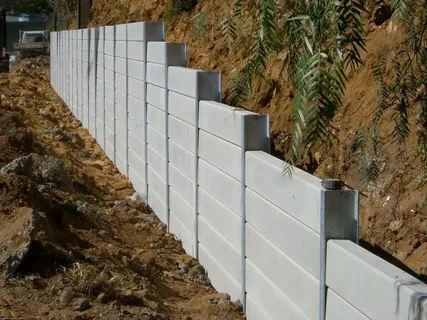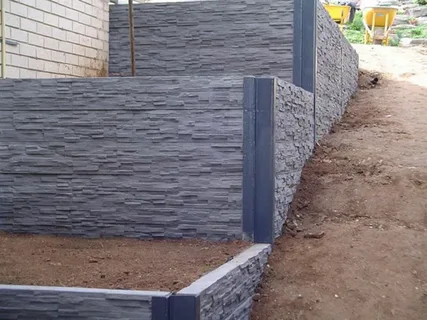Cement sleepers are an essential component in the construction and infrastructure industry, providing stability and durability to various projects. In Brisbane, these cement sleepers play a crucial role in supporting the city’s railway network, as well as being used in landscaping and garden projects. This guide will take you through the fascinating world of Cement Sleepers Brisbane, exploring their manufacturing process, advantages, types, maintenance, and environmental impact, among other things.
Understanding Cement Sleepers and Their Advantages
Cement Sleepers, concrete-based blocks designed for constructing retaining walls, have rapidly gained popularity for their unparalleled strength and longevity. These robust materials outshine traditional options like timber, offering resistance against common detractors such as rot, decay, and pests, notably termites. This resilience translates to a considerably extended service life for retaining structures, a critical consideration given Brisbane’s varied climate.
The importance of cement sleepers cannot be overstated, as they are instrumental in prolonging the lifespan of railway tracks while minimizing the need for frequent maintenance. Their robustness makes them an ideal choice for the climatic challenges in Brisbane, where fluctuating weather conditions necessitate materials that can withstand elements without succumbing to deterioration quickly. Furthermore, their versatility is showcased in their ability to be integrated into various projects, from creating aesthetically pleasing garden paths to erecting sturdy retaining walls that safeguard against soil erosion.
This multipurpose use underscores their value in construction and landscaping projects, making them indispensable in the ongoing development and beautification of Brisbane’s urban and suburban landscapes. Their role is foundational, quite literally, in supporting the infrastructure that keeps the city connected and functional.
 The Aesthetic Versatility of Cement Sleepers
The Aesthetic Versatility of Cement Sleepers
Cement Sleepers offers an impressive range of aesthetic options that cater to diverse design preferences and landscaping themes. Their versatility is key in creating retaining walls that are not just functional but visually appealing as well. Here are some highlights of their design flexibility:
Wide Variety of Textures and Finishes:
From smooth, polished surfaces to rugged, natural stone-like textures, Cement Sleepers can mimic various materials, offering an aesthetic that fits any garden or outdoor space.
Customizable Colors:
Whether you’re looking for a specific color to match your outdoor decor or prefer something that blends seamlessly with the natural environment, Cement Sleepers come in various hues.
Flexible Design Options:
Their modular nature allows for creative layouts, enabling the construction of curved walls, straight lines, or even tiered retaining structures that serve as a focal point in landscape designs.
Integration with Other Elements:
Cement Sleepers can be easily combined with lighting, plants, or decorative features, enhancing outdoor spaces’ overall look and feel while providing practical benefits. The design possibilities with Cement Sleepers are virtually limitless, allowing homeowners and landscapers to craft unique and attractive retaining walls that stand the test of time.
How Cement Sleepers Contribute to Eco-Friendly Construction?
Cement Sleepers represent a significant leap forward in eco-conscious construction practices. As the building industry continues to pivot towards sustainability, these materials emerge as a beacon of environmental responsibility for retaining wall projects. Unlike traditional timber, which depletes forest resources and has a considerable carbon footprint, Cement Sleepers are fabricated from readily available, non-exhaustive materials like sand and aggregate. This shift away from timber mitigates deforestation and reduces the environmental strain associated with timber processing and transportation.
In addition to their strength and durability, cement sleepers boast excellent resistance to extreme weather conditions. Brisbane’s varying climate, with its episodes of intense heat and torrential rain, demands materials that can withstand such environmental challenges. Cement sleepers fit this requirement perfectly, maintaining their integrity despite fluctuations in weather, thereby assuring continuous support to infrastructure projects.
Moreover, their versatility in design and application further amplifies their appeal. Available in various sizes and types, they can be tailored to meet the specific needs of any project, from railway lines to decorative garden paths, making them a flexible solution for diverse construction demands. This adaptability, combined with their environmental resilience, positions cement sleepers as a superior choice in construction and landscaping projects across Brisbane.
Installation Insights: What You Need to Know
Embarking on installing Cement Sleepers for your retaining wall in Brisbane comes with a few essential insights to ensure a smooth and successful project:
Preparation is Key:
Before laying the first sleeper, ensure the ground is level and stable. This might involve excavation and the addition of a compacted gravel base to provide a solid foundation. Failure to properly prepare the site can lead to the wall shifting and instability over time.
Drainage Considerations:
Effective drainage is Behind every successful retaining wall. Incorporate a drainage system behind your Cement Sleepers to prevent water buildup. This typically involves the placement of a perforated drain pipe and backfilling with gravel to facilitate water flow away from the wall.
Professional Advice:
While DIY installation of Cement Sleepers is possible for those with the right skills and tools, consulting with a professional can provide valuable insights, especially for more complex or larger projects. They can offer advice on everything from design and materials to ensuring compliance with local building codes and regulations. By focusing on these critical areas, you can significantly enhance the durability and functionality of your Cement Sleeper retaining wall, creating a lasting and visually appealing structure in your outdoor space.
Cost Comparison: Cement Sleepers vs. Other Materials
When examining the expenses of building a retaining wall, the initial price point is often a primary focus. However, a deeper look into the cost-effectiveness of materials reveals that Cement Sleepers stand out for their value over time. Compared to timber, which may appear less expensive upfront, Cement Sleepers do not require the ongoing maintenance and replacement costs associated with wood’s susceptibility to rot, decay, and termite infestation. This aspect alone makes Cement Sleepers a financially smarter choice in the long run.
Stone, another popular choice for retaining walls, offers a natural aesthetic but comes with a higher price tag for the material itself and the labor-intensive installation process it demands. Conversely, Cement Sleepers offer ease of installation and, due to their manufactured nature, come with a consistent quality and price that can be more easily budgeted for.
Another financial advantage to consider is the potential increase in property value that Cement Sleepers can offer. Their durability and aesthetic flexibility can enhance a property’s overall appeal, making it more attractive to potential buyers. This potential for added value further offsets the initial investment in Cement Sleepers.
While the upfront cost of Cement Sleepers may be higher than some alternatives, their longevity, low maintenance requirements, and aesthetic benefits position them as a cost-effective and attractive option for homeowners. Choosing Cement Sleepers is not just about comparing price tags but understanding the broader financial implications and benefits they bring to a retaining wall project.
Maintenance Tips for Cement Sleeper Retaining Walls
Maintaining your Cement Sleeper retaining wall is relatively simple, ensuring its longevity and aesthetic appeal for years. Here are key tips to keep in mind:
Regular Inspection:
Conduct periodic checks for cracks, signs of wear, or any indications of movement within the wall structure. Early detection of these issues can prevent more significant problems in the future
Clean Surfaces:
Use a soft brush and mild detergent to clean the surfaces of your Cement Sleepers. This will help to remove dirt, grime, and any potential growths, such as moss or mildew, which can detract from their appearance over time.
Drainage Maintenance:
Ensure the drainage system behind your Cement Sleeper wall remains clear and unobstructed. A well-functioning drainage system is crucial in preventing water buildup that could affect the wall’s stability. –
Weed Control:
Keep the area around your Cement Sleeper wall free of weeds and unwanted vegetation. Overgrowth can cause displacement or pressure on the wall, so regularly removing weeds will help maintain its integrity. By following these straightforward maintenance steps, you can help extend the life of your Cement Sleeper retaining wall, preserving its structural and visual quality.
The Environmental Impact of Cement Sleepers
While essential for various construction and infrastructure projects, cement sleepers raise concerns about their environmental footprint. The production process involves significant energy consumption and emits considerable CO2, contributing to global warming. Additionally, extracting raw materials needed for cement manufacturing can lead to habitat destruction and biodiversity loss. Recognizing these impacts, Brisbane is witnessing a shift toward greener alternatives and practices in producing cement sleepers.
Efforts include incorporating recycled materials into the mix, such as fly ash or slag, which reduces the need for virgin resources and decreases the manufacturing process’s overall carbon footprint. Moreover, research into low-carbon cement and more efficient production technologies is underway to lessen the environmental load. On the disposal front, the durability of cement sleepers poses a double-edged sword. At the same time, they last for decades; once they reach the end of their life, recycling or repurposing them becomes a challenge, necessitating innovative solutions for sustainable disposal. The move towards sustainability drives the development of practices and materials that aim to mitigate the adverse effects of the environment, reflecting a growing awareness and commitment to ecological stewardship in Brisbane’s construction sector.
Additionally, some may worry about the environmental impact of using cement-based products. However, the production of Cement Sleepers has evolved to be more environmentally friendly, incorporating sustainable practices and materials. Their durability and longevity also mean less frequent replacements, contributing to a reduction in waste and environmental strain over time.
By addressing these concerns and clarifying misconceptions, Cement Sleepers are a practical choice for retaining walls and offering a wealth of creative and sustainable possibilities. With the right approach, they can be an excellent addition to any landscaping project, combining strength, beauty, and eco-consciousness.
Conclusion
Cement Sleepers Brisbanehave emerged as an outstanding option for retaining walls, marking a significant shift in Brisbane’s landscaping preferences. Their growing popularity is a testament to the myriad benefits they provide, from unparalleled longevity to environmental sustainability. Opting for Cement Sleepers is a wise investment for homeowners, offering a barrier against erosion and an opportunity to elevate the aesthetic appeal of outdoor areas. Their design flexibility and the potential for customization allow for the realization of diverse landscaping visions—ranging from contemporary elegance to traditional charm.
FAQs
1. How long do Cement Sleepers Brisbanelast compared to other materials?
Cement Sleepers boast an impressive lifespan, significantly outperforming traditional materials like timber. When installed correctly and maintained, they can last for decades, making them a more sustainable and cost-effective option in the long run.
2. Are Cement Sleepers easy to install?
While Cement Sleepers are heavier than other materials, modern installation techniques and equipment have simplified the process. For DIY enthusiasts, following proper guidelines can make installation manageable. However, professional assistance is recommended for large or complex projects to ensure optimal outcomes.
3. Can Cement Sleepers be customized for any design?
Yes, one of the standout benefits of Cement Sleepers is their versatility in design. They are available in various textures, colors, and finishes, allowing for a high degree of customization to match any garden theme or landscape design preference, making them suitable for modern and traditional aesthetics.
| Other Good Articles to Read |
| Niche Blogs Connect |
| Blogs 97 |
| Blog Stitution |
| Blogs Unplugged |
| Blogs Cotch Rouge |
| Blog Signatr |
| Blog Sintonias |
| Blog Zilla |
| Consumer Forums |
| Finance Forums |
| G Blogs |
| Too Blog |
| Related Business Listings |
| Contact Directory |
| Local Business Profiles |



